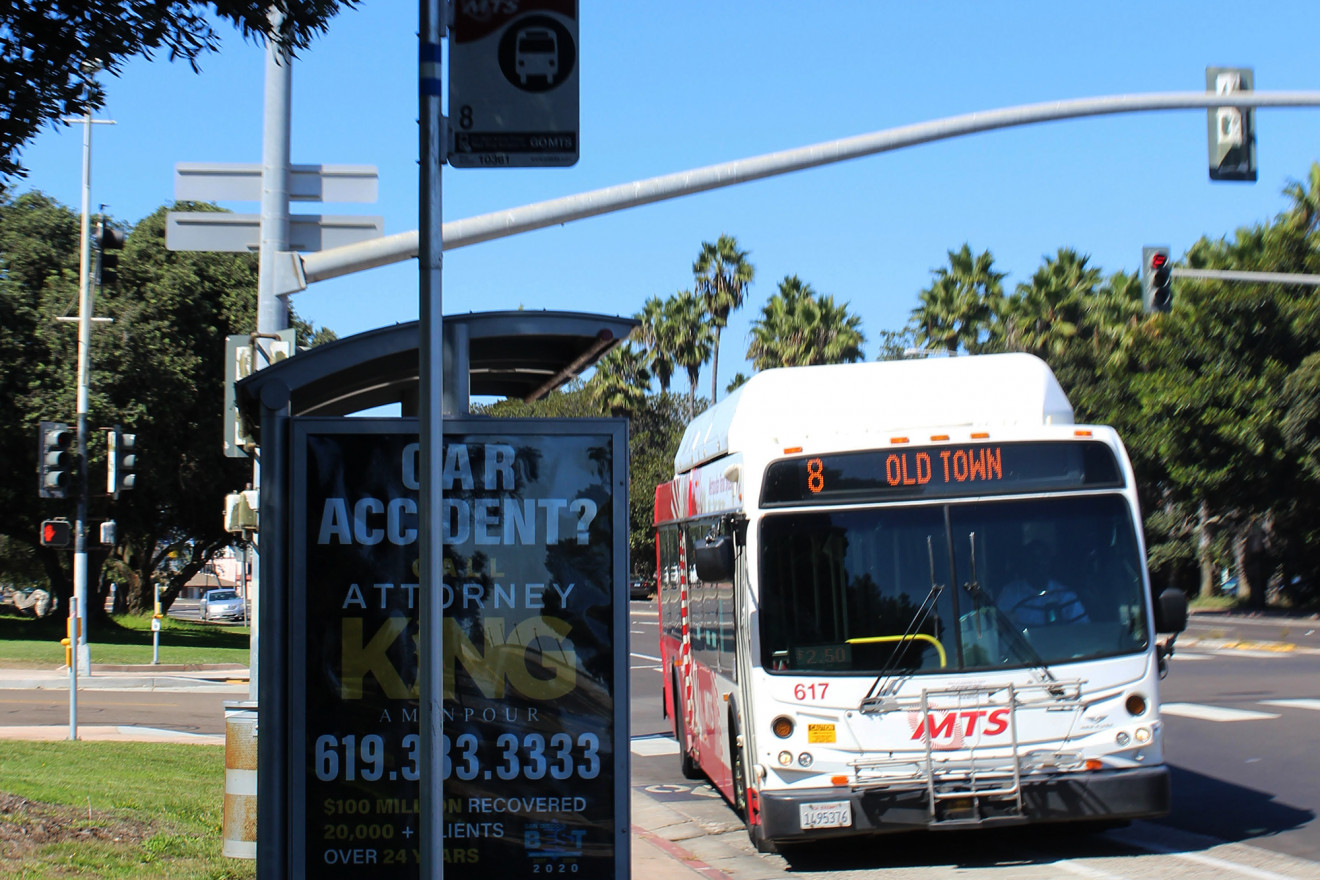
(Image by Maggie Scholle)

(Image by Maggie Scholle)
As the Route 8 bus to Old Town turns down Mission Boulevard, the pixelated white letters of the destination sign flip between three messages. The first is “Go Padres!”– a nod to a recent postseason win. This is followed by the marker of the route, “8-Old Town,” and finally, shown to riders as the bus turns into the stop: “Face Covering Required.” Like nearly every branch of the city, public transit has made notable changes to accommodate for COVID, signage on busses and trolleys among them.
In contrast to other transit networks in major U.S. cities that have made alterations to the frequency of service, the San Diego Metropolitan Transit System (MTS) has been continuing bus and trolley service on schedules nearly identical to those pre-pandemic. According to Brian Lane, a senior transit planner at San Diego Association of Governments (SANDAG), which works in conjunction with MTS, keeping these schedules is crucial for both allowing for social distancing on board with reduced capacity, and ensuring that essential workers throughout the county are able to commute with as little interruption as possible.
One thing that differentiates San Diego from similarly sized cities is the scattered nature of employment centers. The downtown region is the third biggest employment center, following Kearny Mesa and Sorrento Valley, suburban business centers located to the east of downtown. The geographic spread of employment makes improving first and last-mile options a priority, Lane said, citing Palomar Airport as an example. Many businesses are located along Palomar Airport Road, but implementing a new bus line along the street would still leave many commuters at least half-mile from work. It is largely for that reason, Lane says, that shared modes of transit for first and last-mile travel are so critical to the 2021 plan.
The cornerstone of the 2021 regional plan is the “5 Big Moves”: five overarching strategies to change the way San Diegans use transit. All of these moves are contingent on a willingness and motivation for commuters to both switch to or continue using transit.
A global pandemic understandably impedes some efforts to change commuting habits. The most significant losses in ridership occurred in mid-April, according to SANDAG’s regional travel survey. During that month, scheduling was reduced slightly to accommodate the need for drivers and essential transit employees to stay home. April also saw the most marked decreases in ridership attributable to the pandemic: system-wide, there was a 75 percent decrease in ridership.
By the time of a joint meeting between SANDAG’s transportation, regional planning, and borders committees in mid-July, network-wide ridership had recovered by 53 percent. Trolley ridership rebounded quickest, particularly on the Blue Line. The Blue Line Trolley is regarded as the backbone of the MTS network, with many essential workers commuting by a combination of trolley and bus. San Diego transit is unique in that the MTS network serves a bi-national metropolitan area, with Blue Line service at the U.S./Mexico Border in San Ysidro. Though the border has been closed to nonessential travel since March, essential workers have been commuting throughout the pandemic.
While continuing to serve those working in person during the pandemic, SANDAG highlighted the positive environmental impact of teleworking as a means to achieve the 2021 plan’s long-term carbon emission goals. Using data gathered from community-based organizations, SANDAG has set higher teleworking goals for the upcoming year, proposing that up to 25 percent of regional businesses could engage in some form of telework long-term. Further development of the teleworking portion of SANDAG’s iCommute program, which provides resources for organizations looking to transition into telework, is also a facet of the 2021 plan. Although teleworking is connected to a decrease in emissions, the fact remains that those who are teleworking still drive for leisure, a fact that can obscure a clear understanding of exactly what highway driving trends will look like going into the future.
What is much more evident is a persistent, longstanding need for accessible and equitable transit within the county. This is all the more crucial given the demographic of MTS commuters, a group with an average annual income of $17,800 compared to a regional median of approximately $75,000.
During July’s Committee Meeting, Sharon Cooney, the CEO of the MTS board of directors, spoke about trends in the perception of transit as revealed by the 3700 responses to SANDAG’s Regional Transportation Study. The results are promising: only 4 percent of respondents replied that they had used transit in the past, but would not again after COVID. 18 percent of respondents reported having not ridden transit before and expressed an interest in integrating San Diego’s transit network into their travel within the county post-pandemic.
In summary, Cooney said, “Fear of transit is not as profound as we expected.”
While this is an overwhelmingly positive narrative, simply the idea of fearing transit implies that commuting by transit is a choice, which it is not for the 20 percent of MTS commuters who do not have access to a personal vehicle. For these riders, it is not only the innovations brought forth by the 2021 plan, but consistency in and improvements to existing service that will prove critical in the coming months and years.